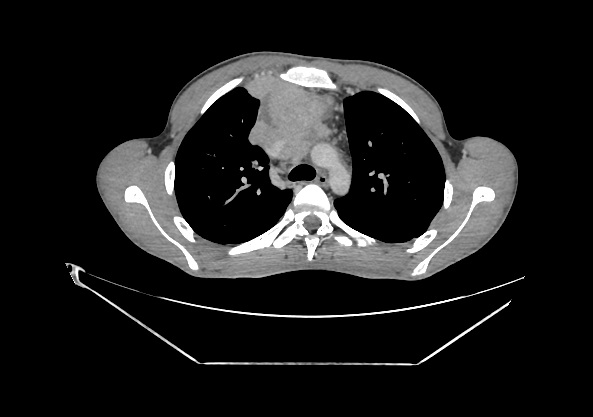NM-359
Anesthetic considerations in a child with malignant thymoma invading the superior vena cava
Chutei A, Zestos M
Children's Hospital of Michigan, Detroit, MI, USA
Thymoma is the most common primary neoplasm within the anterior mediastinum in adults, but in childhood comprises only 1% of cases [1]. Patients can present with symptoms of intrathoracic invasion, exhibit signs of paraneoplastic syndrome, or be asymptomatic and discovered incidentally on chest radiography [2]. We describe a case of an incidentally diagnosed thymoma in a 17 year old boy with no significant medical history.
Our patient presented with symptoms of weight loss and clubbing noted during a routine physical examination. Various imaging modalities yielded a large anterior mediastinal mass with narrowing of the superior vena cava (SVC) due to mass effect, but no invasion into the great vessels. Perioperative anesthetic considerations were multiple, including careful coordination between pediatric general surgery, pediatric cardiothoracic surgery, and pediatric cardiac anesthesia with the hope to avoid cardiopulmonary bypass (CPB) but having the whole CPB circuit and team present and ready. The anesthesia team was prepared for the possibility of an obstructed airway, but induction, intubation, and mechanical ventilation were unremarkable. Invasive monitors were placed in anticipation of CPB. The femoral vein was chosen for central access to avoid the SVC and its contributories which were encased with tumor. Intraoperatively, the thymoma was noted to wrap around and infiltrate walls of the SVC and innominate vein so CPB was implemented as resection of the mass was not possible without disruption of the affected vasculature. A homograft was used to replace a portion of the SVC, and the left innominate vein was sacrificed for complete resection of tumor.
Anterior mediastinal masses in children are typically lymphomas, lymphangiomas, and teratomas, while thymomas are extremely rare, and usually do not invade central veins [3]. Thorough preoperative preparation and team communication are essential in providing meticulous care during such a unique and interesting case.
Top












